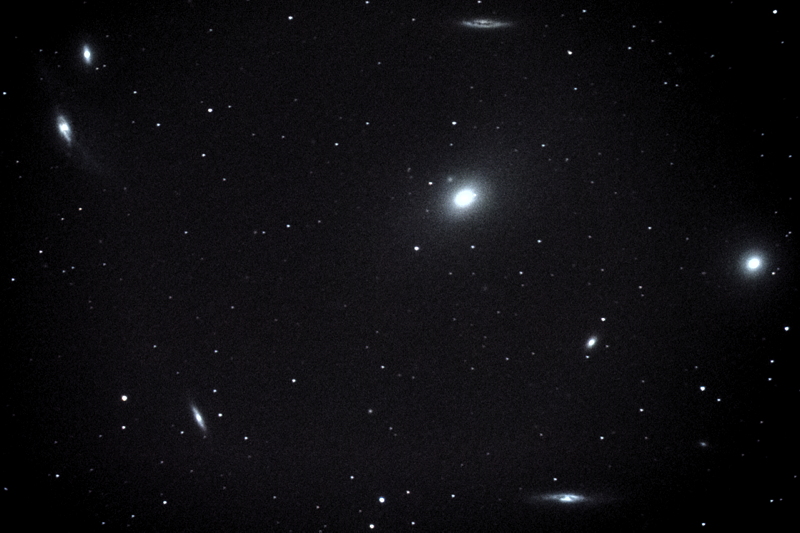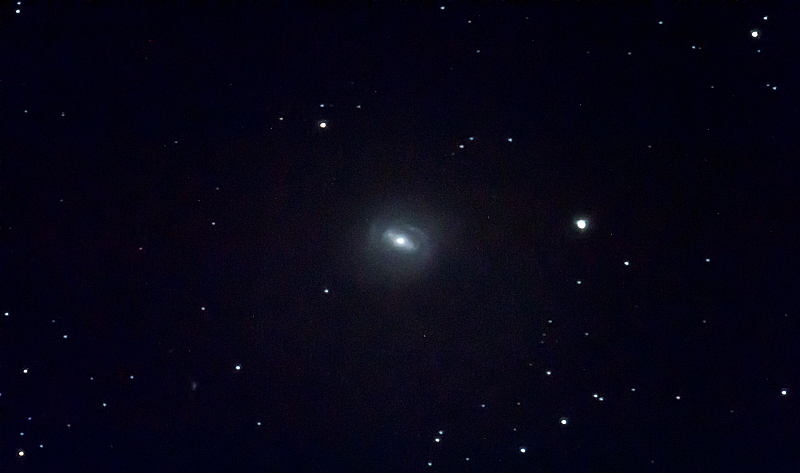D7200 DSLR Virgo Galaxies,
iPhone Sombrero Galaxy
Posted: 23 April 2017
|
Open: Saturday, 22 April 2017, 1838 MST Temperature: 94°F |
Session: 1104 Conditions: Mostly clear |
Equipment Used:
12" f/8 LX600 w/StarLock
2" 24mm UWA eyepiece
2" 30mm eyepiece
Camera:
D7200 DSLR
iPhone 6s Plus
There were some clouds in the sky, west through northeast, when I opened the observatory. After opening the observatory I reclined on the observatory patio bench. I have really enjoyed having this bench here since we added it a month ago. Very convenient.
1901 MST: sunset. 1906 MST: took this iPhone panaroma photo of the sky and the observatory:

Click or tap on image for larger version
1919 MST: LX600 ON, StarLock OFF, High Precision OFF. Viewed Jupiter and four moons, 102X.
Then began preparing the D7200 DSLR for imaging some galaxies in Virgo. Slewed the 12" telescope to M86 (galaxy). Returned to the bench to await a darker sky.
1956 MST: back at the telescope I viewed the galaxies M86 and M84, both in the 102X eyepiece. I then mounted the DSLR at prime focus + focal reducer, slewed to the star Denebola, focused, and locked the primary mirror. Then began waiting for the sky to get a little darker. 2009 MST: slewed to M86. StarLock ON. Began doing some framing test exposures. The StarLock would take a long time to "lock on to" a guide star, and if and when it did, autoguiding was not very good. The same thing occurred on the previous sessions when I was attempting to image this portion of the Virgo Cluster of Galaxies. I seriously began to wonder if the concentration of bright galaxies in the StarLock field-of-view was confusing it. I finally decided to do 10 30-second exposures, ISO 12800, White Balance 3570K, and stack the images. Eight of the images were good for this effective exposure of 4 minutes:

Mouseover or tap on image for labels
2033 MST: StarLock OFF. Removed the focal reducer, focused on the star Denebola, and relocked the mirror. Slewed to M86 (galaxy). 2040 MST: StarLock ON. SYNCed the AutoStar on M86. The StarLock locked onto a guide star but tracking was not good. I decided to use ISO 12800 for these 1 minute exposures, WB 3570K:
M86

M84

Next, slewed to the galaxy M49. As I had hoped and expected, StarLock autoguiding was good now that the telescope was pointed away from the concentration of bright galaxies. At least it was for M49, which is a 5 minute, ISO 6400, WB 3570K exposure. Autoguiding wasn't as good for M58 so that exposure is 1 minute, ISO 6400, WB 3570K.
M49

M58

I will re-image M58 on the next session.
2115 MST: StarLock OFF. Unmounted the camera. Viewed the galaxies M58, M49, and then M104, 102X.
Switched to the 2" 30mm eyepiece (81X) and viewed M104 (Sombrero Galaxy). I mounted the iPhone 6s Plus on the eyepiece using the Levenhuk Smartphone Adapter. StarLock ON. The galaxy was visible on the iPhone screen using the iOS app NightCap Camera (formerly NightCap Pro)! This is a Long Exposure, Light Boost, ISO 8000, 1/3sec, 5 minute exposure showing the Sombrero Galaxy:

Amazing that a smartphone camera can photograph this galaxy!
2145 MST: StarLock OFF. Ended imaging. 2149 MST: LX600 OFF.
|
Close: Saturday, 22 April 2017, 2201 MST Temperature: 69°F |
Session Length: 3h 23m Conditions: Clear |
Comments are welcome using Email. Twitter users can use the button below to tweet this report to your followers. Thanks.
Cassiopeia Observatory Home Page
Copyright ©2017 Michael L. Weasner / mweasner@me.com
URL = http://www.weasner.com/co/Reports/2017/04/23/index.html
